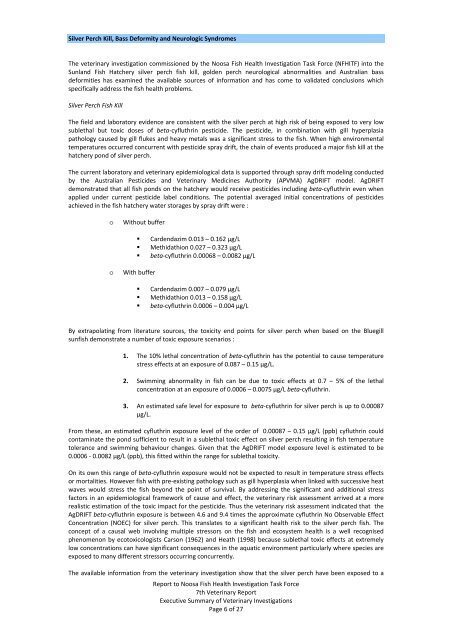37 7th Veterinary Report - Department of Primary Industries ...
37 7th Veterinary Report - Department of Primary Industries ...
37 7th Veterinary Report - Department of Primary Industries ...
You also want an ePaper? Increase the reach of your titles
YUMPU automatically turns print PDFs into web optimized ePapers that Google loves.
Silver Perch Kill, Bass Deformity and Neurologic Syndromes<br />
The veterinary investigation commissioned by the Noosa Fish Health Investigation Task Force (NFHITF) into the<br />
Sunland Fish Hatchery silver perch fish kill, golden perch neurological abnormalities and Australian bass<br />
deformities has examined the available sources <strong>of</strong> information and has come to validated conclusions which<br />
specifically address the fish health problems.<br />
Silver Perch Fish Kill<br />
The field and laboratory evidence are consistent with the silver perch at high risk <strong>of</strong> being exposed to very low<br />
sublethal but toxic doses <strong>of</strong> beta‐cyfluthrin pesticide. The pesticide, in combination with gill hyperplasia<br />
pathology caused by gill flukes and heavy metals was a significant stress to the fish. When high environmental<br />
temperatures occurred concurrent with pesticide spray drift, the chain <strong>of</strong> events produced a major fish kill at the<br />
hatchery pond <strong>of</strong> silver perch.<br />
The current laboratory and veterinary epidemiological data is supported through spray drift modeling conducted<br />
by the Australian Pesticides and <strong>Veterinary</strong> Medicines Authority (APVMA) AgDRIFT model. AgDRIFT<br />
demonstrated that all fish ponds on the hatchery would receive pesticides including beta‐cyfluthrin even when<br />
applied under current pesticide label conditions. The potential averaged initial concentrations <strong>of</strong> pesticides<br />
achieved in the fish hatchery water storages by spray drift were :<br />
o Without buffer<br />
o With buffer<br />
Cardendazim 0.013 – 0.162 µg/L<br />
Methidathion 0.027 – 0.323 µg/L<br />
beta‐cyfluthrin 0.00068 – 0.0082 µg/L<br />
Cardendazim 0.007 – 0.079 µg/L<br />
Methidathion 0.013 – 0.158 µg/L<br />
beta‐cyfluthrin 0.0006 – 0.004 µg/L<br />
By extrapolating from literature sources, the toxicity end points for silver perch when based on the Bluegill<br />
sunfish demonstrate a number <strong>of</strong> toxic exposure scenarios :<br />
1. The 10% lethal concentration <strong>of</strong> beta‐cyfluthrin has the potential to cause temperature<br />
stress effects at an exposure <strong>of</strong> 0.087 – 0.15 µg/L.<br />
2. Swimming abnormality in fish can be due to toxic effects at 0.7 – 5% <strong>of</strong> the lethal<br />
concentration at an exposure <strong>of</strong> 0.0006 – 0.0075 µg/L beta‐cyfluthrin.<br />
3. An estimated safe level for exposure to beta‐cyfluthrin for silver perch is up to 0.00087<br />
µg/L.<br />
From these, an estimated cyfluthrin exposure level <strong>of</strong> the order <strong>of</strong> 0.00087 – 0.15 µg/L (ppb) cyfluthrin could<br />
contaminate the pond sufficient to result in a sublethal toxic effect on silver perch resulting in fish temperature<br />
tolerance and swimming behaviour changes. Given that the AgDRIFT model exposure level is estimated to be<br />
0.0006 ‐ 0.0082 µg/L (ppb), this fitted within the range for sublethal toxicity.<br />
On its own this range <strong>of</strong> beta‐cyfluthrin exposure would not be expected to result in temperature stress effects<br />
or mortalities. However fish with pre‐existing pathology such as gill hyperplasia when linked with successive heat<br />
waves would stress the fish beyond the point <strong>of</strong> survival. By addressing the significant and additional stress<br />
factors in an epidemiological framework <strong>of</strong> cause and effect, the veterinary risk assessment arrived at a more<br />
realistic estimation <strong>of</strong> the toxic impact for the pesticide. Thus the veterinary risk assessment indicated that the<br />
AgDRIFT beta‐cyfluthrin exposure is between 4.6 and 9.4 times the approximate cyfluthrin No Observable Effect<br />
Concentration (NOEC) for silver perch. This translates to a significant health risk to the silver perch fish. The<br />
concept <strong>of</strong> a causal web involving multiple stressors on the fish and ecosystem health is a well recognised<br />
phenomenon by ecotoxicologists Carson (1962) and Heath (1998) because sublethal toxic effects at extremely<br />
low concentrations can have significant consequences in the aquatic environment particularly where species are<br />
exposed to many different stressors occurring concurrently.<br />
The available information from the veterinary investigation show that the silver perch have been exposed to a<br />
<strong>Report</strong> to Noosa Fish Health Investigation Task Force<br />
<strong>7th</strong> <strong>Veterinary</strong> <strong>Report</strong><br />
Executive Summary <strong>of</strong> <strong>Veterinary</strong> Investigations<br />
Page 6 <strong>of</strong> 27

















